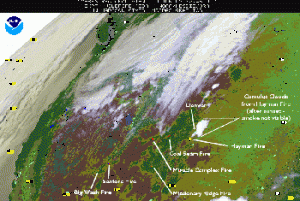New Technique Finds Forest Fires Faster
MADISON, WI, June 19, 2002—Detecting forest fires is now easier for fire-weather forecasters in the National Weather Service and other emergency workers. This summer, NOAA’s National Environmental Satellite, Data, and Information Service (NESDIS) is routinely producing fire products using a technique that automatically detects wildfires in environmental satellite imagery. NOAA and UW–Madison researchers worked together at the Space Science and Engineering Center to develop the technique (or, algorithm) with information from the U.S. geostationary weather satellite, GOES.
The technique is being used to track the Colorado forest fire that started this past week and other western fires.
NOAA researcher Elaine Prins who leads the group’s efforts said that this environmental satellite is the “only one that allows us to detect a fire right after it occurs.” The technique is particularly useful with rapidly growing fires for it can provide information on the fire’s progress in real time. It is also very useful in finding fires in remote areas.
“We have it [the image] out there in 90 minutes and can do it even quicker with new computers,” Prins said. She noted that three years ago it took up to three hours to process a single GOES image over South America. Since then, her group has taken advantage of faster computers to completely revamp the code that processes the satellite information.
Now the product is available over North, Central and South America and is used by climate change research scientists, resource managers, fire managers, and policy and decision makers nationally and internationally. NOAA NESDIS is incorporating the GOES Wild Fire product into the Hazard Mapping System which provides fire products derived from satellite images to the Geospatial Multi-Agency Coordination group for wild land fire support efforts in the United States. The Navy uses the GOES wildfire product to assess and predict smoke transport and effects on visibility.
The Wild Fire satellite product is also used at the National Zoo in an interactive exhibit about the environment and will be used in San Francisco’s Exploratorium. SSEC researcher Joleen Feltz applies the technique to global change issues.
Chris Schmidt (of SSEC) transferred the system, called the GOES Wildfire Automated Biomass Burning Algorithm processing system in March to the NOAA NESDIS Office of Satellite Data Processing and Distribution (OSDPD) Satellite Services Division (SSD) in preparation for the system to become operational this summer. He said, “The new system is fully automated with expanded error checking and reporting capabilities.” Preliminary tests and comparisons of the WF-ABBA fire product produced at SSD and at SSEC’s Cooperative Institute for Meteorological Satellite Studies (CIMSS) indicate that the software system is performing as expected. Standard documentation required by NOAA’s National Environmental Satellite, Data, and Information Service will be delivered in June, in time for the generally most intense period of forest fires.
“A wide range of products that were developed in Wisconsin from GOES measurements are now operationally produced by NOAA/NESDIS in Washington, DC. This includes information on atmospheric motions, Sea Surface Temperature, atmospheric moisture and stability, and clouds,” said Tim Schmit, NOAA researcher at SSEC who heads the group producing most products from GOES data.
Each cooperative institute makes an agreement with the government to research a different scientific topic of public import. Products developed from that research are shared with the government when they’re proven stable enough to use at any time under the conditions for which they were developed. CIMSS focuses on developing products from satellite data that will help make more accurate forecasts. The Wild Fire algorithm is the latest in a string of products developed at UW–Madison that are being used routinely by the National Weather Service and elsewhere.
Contacts: SSEC’s Public Information Officer, 608-263-3373, Elaine Prins, 608-263-6607
For other SSEC stories, visit the SSEC news page.

